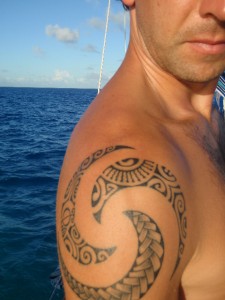Sep 16 2010
Engine Repair Part 2
After spending three days relaxing, hanging out in cafes, recovering from sailing so much the last two weeks, we decided we were ready to move on to other anchorages in Tonga. Our engine had other plans.
The engine performed admirably since Matt and I patched it, motoring for ten hours or more enroute to Tonga. But less than 60 seconds after having left the mooring we were at just off Neifu, less than 60 seconds into our foray into the fun side of Tonga and away from the cafe side of Tonga, the exhaust manifold sheered a bolt again. And snapped the hose clamps we had added. Back to the mooring ball. Back to Aquarium requesting additional days on the mooring. Back to mind-numbing cafes.
We formulated a new plan which involved putting all efforts into getting out the sheered bolt that still had the extractor bit inside it. Then, we would construct a bracket to brace the heavy exhaust elbow infrastructure, hopefully reducing its vibration and consequently its tendency to sheer.
The next morning I took a taxi to the hardware stores and purchased eight new drill bits. Getting out the extractor bit would be no easy task. I then set upon trying. I drilled. 1 bit broke. And another. And another.
Four hours later, I was exhausted, frustrated, indignant, furious, and capable of going no further. I opened a beer and popped in an episode of West Wing. One episode turned in to ten as I drowned my misery and anger in escapism.
The next day, Matt took his turn. Similar results ensued.
The next day, I took the drill. Our engine block at this point had drill holes down all four sides of the bolt with the extractor bit in it. We had broken nearly a dozen drill bits. Dulled beyond use another dozen. Used drill bits ranging from 3/64” up to 1/2”. The gauge around the extractor bit was twice as big as the bolt that originally went through it.
And then, after more multiple hours of drilling, the extractor bit wiggled. The smallest of movements! This tiny victory buoyed my spirits as I drilled for another hour until it was finally freed! Celebration ensued. Much beer was drank.
The next day, Matt re-tapped holes into the engine block. They are suspect, as the holes we tapped are 5/16” coarse thread instead of the original 5/16” fine thread. And the hole which originally had the extractor bit inside the bolt in it, well the surface of that bolt hole is gouged down so far that very few threads seem to actually contact the new fine thread bolt.
We enlarged the bolt holes going through the exhaust manifold. And most importantly, Matt added a beefy bracket that definitely reduced vibration in the exhaust elbow.
Four days later, we were ready to leave again. We turned on the engine. We waited anxiously. Straining our ears for odd sounds. Squinting our eyes to look for unusual vibration. All appeared normal. Maybe it worked!
We gingerly left Neifu and went exploring some other anchorages in Tonga. Now in Fiji, the engine has motored plenty and is holding up fine. We have guests arriving though, Gary, Anna, and Allison, and if the engine wanted to break again, now would be a most inopportune time to do it. We really hope it doesn’t!
